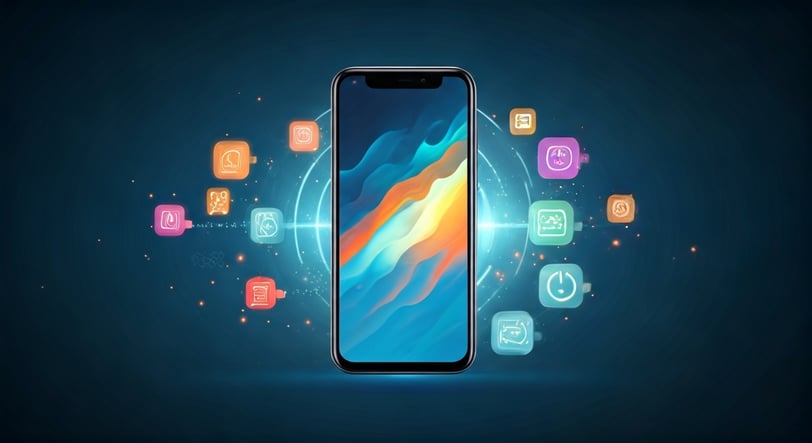
Best Practices for Reducing App Battery Drain
Did you know that as many as 63% of people remove apps because of heavy battery drain? Many mobile users count on their phones all day. That is why good battery performance can be so important. Some apps use up more battery because of big jobs they do, too many network calls, or working in the background when the user does not need them. All of these things will lead to more power consumption. If you learn what causes battery drain and use the right optimization steps, you can make sure your app runs well. Better battery use means higher user satisfaction. Here, we look at the best practices to cut down battery drain and help your app do well in performance with mobile users.
MOBILE APP DEVELOPMENT
Key Highlights
Learn actionable methods to reduce app battery drain and effectively enhance battery life across devices.
Discover how managing background processes smartly can minimize unnecessary power consumption.
Gain insights into leveraging tools like HTTP caching and WorkManager to optimize battery usage.
Understand the role of features such as adaptive battery and dark mode in conserving energy.
Explore strategies to improve resource-heavy operations and streamline network requests for better battery efficiency.
Get acquainted with tools like Battery Historian to diagnose and resolve battery performance challenges effectively.
Transitioning into the introduction, let’s set the stage for understanding the common causes of excessive battery drain and solutions to mitigate it.
Introduction
Did you know that as many as 63% of people remove apps because of heavy battery drain? Many mobile users count on their phones all day. That is why good battery performance can be so important. Some apps use up more battery because of big jobs they do, too many network calls, or working in the background when the user does not need them. All of these things will lead to more power consumption. If you learn what causes battery drain and use the right optimization steps, you can make sure your app runs well. Better battery use means higher user satisfaction. Here, we look at the best practices to cut down battery drain and help your app do well in performance with mobile users.
Essential Best Practices for Reducing App Battery Drain
Cutting down battery usage comes from using smart steps to improve your app. For instance, you should try to stop background tasks that are not needed. You can also cut down on network requests that use a lot of power. Look for ways to make big jobs in your app use less energy. Small changes like these can make a big difference in battery drain. By planning your app’s design well and using tools to check how much battery it uses, you can make apps that still work well with less energy use.
Each of these ways is meant to help with one area of battery drain. Below, we go over the top ways to boost battery performance in apps and make users happier.
1. Optimize Background Process Management
Managing background processes well is key to saving battery power in apps. Many background tasks, such as data refresh or syncing, can use a lot of battery—this is common in social media or streaming apps. Tools on android, like WorkManager or JobScheduler, help by delaying tasks that are not important, so a device uses less power when it is not in use. For example, grouping background updates together makes the cpu wake up less often. This helps other apps too and keeps battery efficiency high.
By cutting down on things that don't need to run in the background, the battery life is better. Features such as Doze Mode on android stop tasks that are not needed when the phone is not moving. This helps save power and gives a longer time on one charge. Developers need to use these features in a smart way. They have to find a good balance between what the app can do for the user and how much battery it uses.
Some apps, like those for maps, need to keep tracking the user’s location in the background. To save power, it helps to use frameworks that only run these updates when needed. If these background processes are limited to when the user actually needs them, battery power is saved and the user experience stays good.
2. Limit Unnecessary Network Requests
Many network calls that are not managed can use up your device’s battery very fast. Every time your app sends a network request, it turns on hardware like Wi-Fi, LTE radios, and uses the system’s processor. This makes the device use more power. If you group network requests together, or update data every so often instead of all the time, you can lower how much power is used. When you use batch processing, your device can stay in low-power mode longer. It will wait before waking up to deal with all the data at once.
There are also other good ways to save battery life, such as HTTP caching and using local storage in your apps. With caching, your app saves data from the server so it does not have to keep making the same network calls. This helps to save battery and makes your app load pages faster. For instance, the OkHttp library has built-in caching that cuts down on how much data your app fetches from the network.
3. Use Efficient Data Syncing Strategies
One hidden cause of poor battery performance is bad data syncing. To fix this, developers can use on-demand syncing and set up priority scheduling platforms like Firebase. These systems update data only when needed. This limits the need for constant syncing and helps improve the battery performance.
It is better to switch from global, all-device syncing to using incremental updates. With this method, only new or changed data is synced. This way, the app saves bandwidth and cuts down on energy consumption. Adding smart syncing algorithms can also help reduce the number of data transfers needed.
There are ways to change syncing automatically along with the battery saver modes. When battery gets low, the app can slow down how often it syncs. These steps not only help the battery last longer, but also keep the app running well. Users get a smoother user experience and their devices don’t get overworked.
4. Minimize Wake Locks and Alarms
Wake locks keep your device from going to sleep and alarms that run too often can cause a lot of battery drain. If you do not manage wake locks well, the CPU stays on even when it is not needed. This leads to high battery usage. With Android’s AlarmManager, developers can plan tasks more carefully. This helps to cut down on useless wake cycles and gets the most out of battery life.
To lower battery drain from alarms, you can use exponential backoff strategies. These plans make sure alarms do not go off at set times but instead space them out over time. This way, the device can save battery life and not have the CPU working too much.
It is also a good idea to trade many wake-lock actions for things like Geofencing. This type of functionality lets location services turn on only if the user crosses preset lines. By removing extra alarms and checking real-time needs, you keep up performance and energy savings at the same time. This will help with battery usage in your Android device, so people get good use out of their phone or tablet for longer.
5. Reduce Resource-Heavy Operations
High-demand jobs like playing videos in high-definition or live picture processing can cause a big jump in power consumption. Apps can lower this by using smart optimization steps, including:
Implement dark mode: On OLED screens, using a dark theme makes the pixels need less power, up to 60% less.
Optimize animation usage: Simple animations put less pressure on the CPU and GPU, cutting power usage.
Use object pooling: The app should use the same objects instead of making new ones each time.
Leverage efficient libraries: If developers use smaller, better frameworks, the work will use less energy.
In real life, working on Google Maps’ location services shows how less overhead helps navigation apps. With the right measures, apps like these make sure they only use the right amount of power for every purpose. Good optimization helps to keep power usagelow when the app does heavy work.
6. Implement Adaptive Battery Features
Adaptive battery settings in most Android devices use machine learning to change how apps run in the background. These battery settings focus on the apps you use the most. They limit what the other apps can do. This helps make sure your battery is used by the apps that need it.
Android Adaptive Battery will manage background processes when you use the device less. For developers, using these features lets low-priority tasks pause. This means the device can stay active for a longer time.
The adaptive battery system also looks at usage trends to guess future power needs. It stops tasks that are not needed based on past app performance and how you use your android devices. This setup helps apps work better and gives good resource use by the apps.
7. Optimize Location Services Usage
Location services use a lot of battery, especially if they rely on continuous GPS tracking. This can be one of the most power-hungry app features. To help lower battery consumption, you can use geofencing. Geofencing only works when the user moves into or out of a certain area. This way, the app does not always keep the GPS on. If you must use real-time location tracking, you can save battery by letting the app update location less often. You do not have to keep the GPS running at high accuracy all the time, unless it is needed. Make sure the device sensors are managed well. This way, you can still collect the data you need without using up the battery too fast. This is a good way to balance smart location tracking with battery life.
8. Streamline Push Notification Frequency
Too many push notifications can keep a device on and use up battery fast. To fix this, apps can use batch notification delivery. This method sends several alerts together. With this, there are less times the device wakes up, which helps reduce battery drain. At the same time, users still get the updates they need.
Firebase Cloud Messaging (FCM) is a good tool for sending notifications in a smarter way. It lets the device group messages, so the CPU does not wake up as often. Apps can also use syncing to match notifications with when people are most active or with their time zones.
Limiting updates that happen often to only the most important alerts, and sending less urgent messages later, can cut down battery use. By choosing which notifications to send and when, apps make the device work better and help keep user satisfaction high.
9. Monitor and Reduce CPU Intensive Tasks
Tasks that use a lot of CPU activity, like heavy data work and drawing animations while running, can drain a phone battery fast. Developers need to look for these costly algorithms where they use a lot of power. You can check this with profiling tools like Android Profiler or Energy Diagnosis Templates.
There are a few ways to help. You can make your game’s engine better by lowering how often drawings update. Do this when people are not using it much. You can also handle many media parts at the same time, but split them up well. Changing these jobs to run at times when the phone is not busy will help save battery. For example, projects like SideKick worked on fixing hardcoded trade speeds and moved tasks around to help out.
10. Employ Battery Usage Analysis Tools
Battery usage analysis tools are important for improving app performance. These tools show details about how much power an app uses. Developers use these details to find out what causes battery drain. They can look for places where their app uses too much power or where there are problems.
With features like battery historian, people can check background processes, watch what network requests the app is making, and look at screen brightness settings in the app. All these things help to cut down on battery usage.
When developers use these tools, they get the information they need to make better choices about app design. This can lead to fewer inefficiencies, better battery efficiency, and improved functionality. People who use the app will be happier because the battery drains less and the experience gets better.
Advanced Techniques for Battery Optimization
There are some new ways to boost battery efficiency and make the battery life of your device longer. For example, energy-aware APIs help developers manage background processes better. This means your app can use less battery while you use it. Turning on power-saving modes for different devices can also help lower power consumption.
Using battery-friendly UI and UX designs is important too. Things like dark mode and fewer heavy animations can improve battery health. These changes also bring a good user experience.
All of these techniques together can improve app performance and user satisfaction. This matches the goal of saving battery life and cutting down on battery drain across different devices.
Utilize Energy-Aware APIs
Energy-aware APIs help improve battery performance in apps. Developers use these APIs to lower power consumption from background processes and real-time features. For example, Google location services help control when and how the app uses location data. This cuts down battery drain. Using these tools, developers can also make better algorithms. These smarter algorithms change to fit what people do, so the app works better. At the same time, it keeps battery efficiency high and can help device battery life last longer. This is good for users and their devices.
Leverage Device-Specific Power Saving Modes
Using power saving modes that are made for your device can help improve battery life, especially when apps use a lot of power. Each smartphone has settings that are right for its own hardware. These settings let apps change how much power they use in real time. Turning on these modes often cuts down background processes, lowers network requests, and makes the screen brightness less. When app makers add these features, they can help boost battery efficiency and still keep the key things that people need. This helps with user satisfaction and makes people want to keep using the app. Using these new strategies is very important to get the best battery performance.
Integrate Battery-Friendly UI/UX Designs
Designing user interfaces with battery efficiency in mind helps the app perform better and makes users happier. Dark mode is good for this. It lowers screen brightness, which saves battery power and also makes the screen easier to see. Also, using fewer animations and making the layout work well with less load on the cpu helps cut down on energy consumption. When you add location services with care and control background processes in your apps, you use the device’s battery life in a smarter way. These steps improve functionality and keep battery usage low. This makes users enjoy their time on the app more, and their battery lasts longer.
Conclusion
Using smart ways to do battery optimization makes the user experience much better and helps stop battery drain. When developers use energy-aware APIs and turn on device’s built-in power-saving modes, they can improve app performance and boost user satisfaction. If apps use battery-friendly UX/UI designs, background processes will run better, so the device’s battery life lasts longer. By looking at battery consumption and making smart changes, mobile developers can create apps that have good functionality, help battery life, and use less power. This balance gives people a better way to use their phones and helps make our digital world more responsible.
Frequently Asked Questions
What are the main causes of excessive app battery drain?
Too much app battery drain can happen for a few reasons. Some of these are high background activity, using location services too often, and code that is not made well. Heavy graphics in the app can also use up the battery. When you use old libraries or do not use power-saving features, the battery performance gets even worse.
How can I test my app’s battery consumption?
To check your app’s battery consumption, use tools that watch energy use while the app runs. Look at the reports to see what makes battery life go down. Change your app to help it use less power in those areas. If you keep testing, you can help your app work well and cut down on battery drain.
Do background apps always drain battery?
Background apps can use up your battery, but how much they do depends on what they do and the permissions they have. Some apps always run tasks and use resources. Others may stop working when you are not using them. To get the best battery life and still keep all the functionality you need, it is important to manage the settings for background apps.
Are there tools to help monitor and optimize battery use?
Yes, there are apps that can help watch and improve battery usage. Tools like AccuBattery and Greenify give good details about your battery performance. They help you see which apps use the most power. Also, the device has built-in settings. You can use these to track energy consumption and turn on battery optimization. This helps your battery life last longer.



